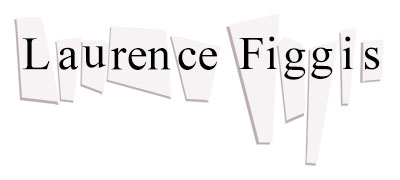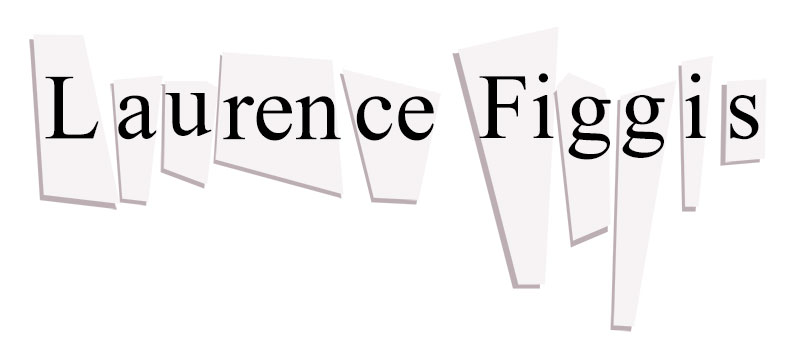About ‘The Great Macguffin’
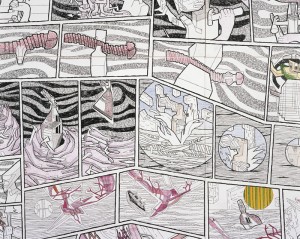
Laurence Figgis, The Great Macguffin (detail), 2005-12, ink, crayon, watercolour on paper, 160 x 350 cm
I first stumbled on the (great) MacGuffin in 2005, when I was searching for a title for a piece of work that was then in production, a large scale ink and watercolour drawing that had occupied my attention for some months. I was still in the throes of making this work when I read Alfred Hitchcock’s account of the term in his seminal interview with François Truffaut. And I knew straight away that I had found not only the title for the work but also the name for its protagonist, the imaginary character (part human, part animal, part machine) with whose fortunes the drawing is principally concerned. The word itself struck me with its amusing lyric – or rather non-lyric -quality; I liked the heavy, cumbersome, down-to-earth sound. But the explanation behind the word was just as captivating.
‘MacGuffin’ is Hitchcock’s term for a pretext or plot device that in its typical and most intellectually satisfying form must always be radically under-explained within the diegetic narrative. In many cases it would not hold up to rational scrutiny if the audience subjected it to any attention. Thus in Hitchcock’s film Notorious (1946) we are led to assume that particles of uranium (viable for atomic capability) can be stored in wine bottles in the form of a crystalline black dust, hidden in the chief antagonist’s cellar.
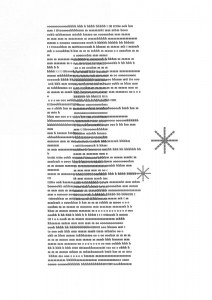
Laurence Figgis, The Great Macguffin (limited edition poster) (detail), 2009, 59.9 x 85 cm
Just how such an object related to my drawing (theoretically speaking) I wasn’t entirely sure. But the notes I made in an attempt to explain the connection eventually evolved into The Great Macguffin prose poem: an autonomous work of fiction. (This poem in turn formed the basis for a live performance which took place at the Old Hairdresser’s in Glasgow in the Spring of 2012). I should acknowledge that by the end of writing the poem I had wearied of any inclination to rationalise my terms. And the text that follows (and which precedes a recitation of The Great Macguffin poem itself) does not attempt to explain the poem after the fact. It poses the question ‘what is a MacGuffin?’ as such a question might be posed in the imaginary field of the wundermärchen or fairy tale (not in the thriller that was Hitchcock’s metier).
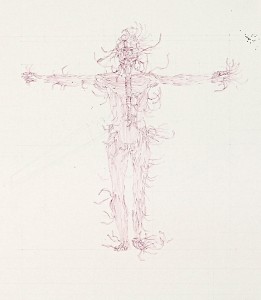
Laurence Figgis, Admine, 2004, ink, pencil on paper, 29 x 42 cm
Firstly we should state that though the MacGuffin was nearly always an object or collection of objects in Hitchcock’s cinema (a wine bottle, an envelope of stolen cash, some secret government papers), the word ‘MacGuffin’ itself sounds like a name, connoting an aspect of human subjectivity – or at the very least an anthropomorphic dimension. At the same time, the article with which the term is always coupled (Hitchcock speaks of ‘the’ or ‘a’ MacGuffin) suggests that we are dealing with a common rather than a proper noun. By extrapolation we might surmise that, firstly, if the term designates a human subject, it is less of a Christian or family name for that subject than a word for its role, office or job; that, secondly, if the MacGuffin is alive, it might be more of a creature than a person – perhaps a nonsensical animal like those found in children’s stories – the Grinch, the Gruffalo, the Psammead, the MacGuffin.
Above all the very sound of the word enciphers its manifest lack of content; it has the air of a ‘thingamajig’ or ‘whatsit,’ arising in the flow of speech when a more precise term cannot be called to mind. Hitchcock’s own favourite example was that occurring in North by Northwest (1959) in which the evil agent portrayed by James Mason is said to be exporting nothing more particular than ‘Government secrets’. ‘Here, you see, the MacGuffin has been boiled down to its purest expression: nothing at all!’ (Hitchcock qtd. in Truffaut, 1985: 139). Negation is an important corollary of the ‘great’ MacGuffin. In Hitchcock’s famous parable, a man travelling by train through Scotland inquires about an oddly-shaped package. His friend replies: ‘That’s a MacGuffin, proceeding to explain its function – it is a device for ‘trapping lions in the Scottish Highlands’. ‘But there are no lions in the Scottish Highlands’ his friend replies, to which the first answers, ‘Well then, that’s no MacGuffin’ (Hitchcock qtd. in Truffaut, 1985: 138).
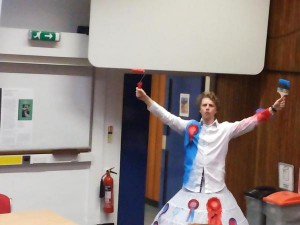
Laurence Figgis, About the Great Macguffin, 2015 (documentation of live performance)
We find ourselves, then, in the presence of a rather fraught composite entity: a thing that is also a person that is also sort of creature or animal, defined by its vital structural function and by its ultimate lack of substance or integrity. The fairy tales of Hans Christian Andersen are crowded with examples of just this sort of liminal object of ‘things that talk and move and have consciousness and identity’. For the writer and mythographer Marina Warner, this ‘intermediate category of being’ occurs through ‘analogy with children’s games in which the playing child gives voice to the toy’ (Warner, 2008). Given, however that the MacGuffin is not necessarily a thing but rather a structural component in language that can sometimes be manifested as a thing, we should regard it as belonging to a peculiar strand of metaphysical sympathy – that pertaining to the depiction of abstract or intangible concepts as human figures. This tradition, associated in the West with neo-classical forms of allegory, the personification of ‘Time’, ‘Truth’, ‘The Arts’, relies on our ability to imagine even non-material phenomena as endowed with will, intention, and personality.
The MacGuffin (figured as a person as well as a thing) carries this act of projection as far as the formal structure of language itself. By the same logic, if the MacGuffin is somehow like a person, then a verb, a noun, an article, punctuation, could all become players in a human drama that explains – or convulses – the laws of grammatical structure, while in the field of narratology, the motive, the protagonist, the deus-ex-machina, could likewise be imagined as discrete (conscious) entities. The same goes for the language of visual deconstruction. In his book Inside the White Cube, the critic Brian O’Doherty proposed (with emphatic tongue-in-cheek) a series of cautionary tales that would explain the history of modernist painting for children. These stories would have titles: ‘How the Edge Revolted Against the Centre’, ‘Who Killed Illusion?’ and the tale of ‘The Vanishing Impasto that Soaked Away’. For O’Doherty the ‘Edge’, the ‘Centre’, the ‘Impasto’ are characters; the internal (formal) relations of elite modernist objects are themselves re-imagined directly in terms of narratives about social relations – there is even a hint of the vulgar Oedipal conflicts of soap-opera and melodrama. As O’Doherty himself puts it:
And how would we tell the story of the little Picture Plane that grew up and got so mean? How it evicted everybody, including Father Perspective and Mother Space, who had raised such nice real children, and left behind only this horrid result of an incestuous affair called Abstraction, who looked down on everybody, including – eventually – its buddies, Metaphor and Ambiguity; and how Abstraction and the Picture Plane, thick as thieves, kept booting out a persistent guttersnipe named Collage, who just wouldn’t give up. (O’Doherty, 1999: 35).
We cannot escape the mocking tone of this parable, the effect of which is to hold ‘the abstract’ in the grip of narrative. Its lesson is familiar for students of late-20th-century art; even in the high-formalist phase of the post-war American avant-garde, painting could not be free of stories – at least not of the potential narrative formed from any account of its internal compositional relations (and the artist’s struggle with and mastery of those relations). But this is only the beginning of a larger story; indeed subsequent practitioners would seek to dispose of these relations altogether. In the work of the minimalist and conceptual artists of the mid-to-late 1960s even the ‘arrogant little picture plane’ would struggle to find a home. The IDEA that the IDEA of the IDEA itself eclipses the work itself, or constitutes the work itself led inexorably to the much touted ‘de-materialisation of the art object’ – though as Alexander Alberro has argued the dealers and promotors of contemporary art continued to find ingenious ways to market and commodify these apparently none-existent or invisible objects for buyers and collectors.

Laurence Figgis, About the Great Macguffin, 2015 (performance costume and props), various media, dimensions
The legacy of the conceptual turn, that the art object is ‘no longer experienced as autonomous, rounded, and whole’ – as ‘perpetually present for the viewer to behold and decode’ – but rather as ‘dialogically engaged with its historicity, context and temporality,’ continues to endure even the face of what can only be described as a vulgar ‘re-materialisation’ of the art object in recent years. But the distinction might be that whereas the conceptual art of the late-sixties engaged actively with its context, the work of more recent times has been subject to a passive and silent role within these frameworks. In other words it has been reduced to the status of a MacGuffin, a mere cipher or pretext in the network of financial, bureaucratic and ideological exchanges that constitute the art world. As Alberro has described this process; just as advertising ‘transfigures object forms (use value) and commodity forms (exchange value) into sign values’, the art work has been reduced to a ‘sign system’ whereby ‘economic power becomes visibly transformed into the trappings of social privilege’ (Alberro, 2003: 120)
What remains arresting at this stage, however, is the existential poetic value embodied in the whole notion of the art object as MacGuffin (the morbid currency suggested in the hint of subjectivity – the anthropomorphic flavour of an abstraction that sounds like a proper name).
PRESENTATION CONCLUDED WITH A RECITATION OF ‘THE GREAT MACGUFFIN’ PROSE-POEM
References
Alberro, Alexander. Conceptual Art and the Politics of Publicity. Cambridge, Mass.; London: MIT Press, 2003.
O’Doherty, Brian. Inside the White Cube: The Ideology of the Gallery Space. Berkeley, Calif.; Los Angeles, Calif.; London: University of California Press, 1999.
Truffaut, François. Hitchcock. Rev. ed. New York: Simon & Schuster, 1985.
Warner, Marina. ‘The Voice of the Toy: Writing Magic and Enchanted States’. Lecture delivered at Stanford University, Stanford, 14th April, 2008) http://www.youtube.com/watch?v=Qr6OSCbVmQk.
This paper was delivered for the conference, ‘Silence: A Semiotics of (In)Significance‘, University of Liverpool, 1st-3rd July, 2015
